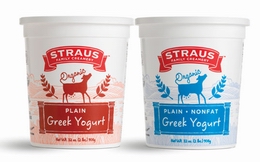 Even with Greek yogurt growing in American markets and consumers flocking to anything with live, active cultures, 2012 may be best remembered as a year associated with milk’s diminished role.
Even with Greek yogurt growing in American markets and consumers flocking to anything with live, active cultures, 2012 may be best remembered as a year associated with milk’s diminished role.Last August, a U.S. Department of Agriculture report said domestic 2011 beverage milk sales tallied 53 billion pounds (roughly 6 billion gallons), the market’s poorest performance since 1984. Whole milk beverage sales in 2011 stood at less than half of 1980s’ levels, the report noted. It cited such factors as shifting consumer preferences and other new beverages.
Recognizing the challenge, the dairy industry has drawn a line in the sand around the breakfast daypart, as Americans continue to consume more milk at the breakfast table than any other meal. The industry also is relying upon chocolate milk’s protein, carbohydrates and sodium and—in some circles—industry leaders are positioning the drink as a sports recovery beverage.
For consumers concerned about the lactose in dairy milk, scientists at Inner Mongolia Agricultural University in China say they have bred the world’s first genetically modified calf that will produce low-lactose milk within two years. The fetus received a lactose dissolution enzyme, which dissolves the offending ingredient into galactose or glucose. Officials expect the calf, named Lakes, to produce low-lactose milk after she reaches 25 months of age.
Lactose concerns were not the only dilemma facing the milk industry in 2012. Late in the year, one report suggested too much milk consumption could be detrimental. When researchers at St. Michael’s Hospital in Toronto investigated milk intake and compared that with iron and vitamin D levels in 1,300 preschoolers, they found drinking two or more cups of milk a day seemed optimal. However, children who consumed more than two glasses a day risked lowering the amount of iron stored in their bodies and raised the risk for anemia. While the research, published in the journal Pediatrics, was unclear about whether drinking milk directly blocked iron absorption or if its impact was less direct, the researchers did suggest a two-cup-a-day limit, as recommended by the American Academy of Pediatrics.
On the other hand, Sweden’s University of Lund had better news for milk drinkers. Scientists there found milk protein (lactoferricin4-14) may reduce the growth rate of colon cancer cells, over time. The findings followed a number of studies relating milk consumption to improved health, notably a decreased risk of diabetes, metabolic syndrome and colon cancer.
That said, if there was a healthy star in the dairy universe in 2012, it would have been the continued probiotic phenomenon, and it is by no means limited to North America. A market report from Transparency Market Research, “Probiotics Market (Dietary Supplements, Animal Feed, Foods & Beverages)—Global Industry Analysis,” finds the global probiotics demand stood at $27.9 billion in 2011. Furthermore, the trend shows no sign of slowing. That report also predicts the global probiotics market will reach $44.9 billion by 2018, with a compound annual growth rate of 6.8% from 2013-2018, led by Asia-Pacific and Europe, with the former expected to be “the most promising market in the near future.”
Stateside, probiotic fortification continued unabated in 2012. Hain Celestial launched a low-fat kefir cultured milk under its Greek Gods brand. Greek Gods Kefir may be low in fat, but it also features 12g of protein, is gluten-free and 99% fat-free. The line also emphasizes honey, as the flavor factors in three of the four varieties: Honey, Honey Vanilla and Honey & Strawberry (in addition to plain). Extending the Greek Gods brand, popular in the Greek yogurt segment, gives Hain Celestial a familiar selling point among consumers in the growing kefir market.
That market has, by and large, been dominated by Lifeway Kefir, and that company also added a new flavor to the mix in 2012, although it was primarily a limited, seasonal option. Lifeway brought back its holiday-themed kefir smoothies and added a new flavor option to the bunch: Gingerbread, joining Pumpkin Spice and Cranberry Crème Brulee in the collection. Available only through December, each of the options promised 12 live and active cultures, including Lactobacillus lactis, Lactobacillus acidophilus, Streptococcus diacetylactis and Bifidobacterium lactis. They also were gluten-free and 99% lactose-free.
Yakult U.S.A. Inc. also added a probiotic-rich drink, Yakult Light. It features an active probiotic called Lactobacillus casei of the Shirota strain, a strain exclusive to the Yakult brand. Made with natural sweeteners and flavors, Yakult Light boasts no preservatives, gluten or high-fructose corn syrup, while it weighs in at 30 calories per bottle (compared to 50 calories in regular Yakult).
Greek to Everybody
How big is Greek yogurt? Less than three years ago, Greek yogurt sales accounted for roughly 3% of the overall yogurt category sales; in 2012, nearly one third of all U.S. yogurt sales are Greek varieties. And, analysts forecast the segment will grow 120% over the next five years.
Interestingly enough, those sales figures came from a category newcomer, the Jamba Juice retail chain. After doing its homework, Jamba entered the fray with a line of new Greek Yogurt Superfruit Smoothies. The new “at-home” offering combines non-fat Greek yogurt with on-trend superfruits pomegranate and açai. Pomegranate Pick-Me-Up features whole frozen blueberries and raspberries, sliced strawberries, pomegranate and frozen non-fat Greek yogurt, while Acai Super-Antioxidant features whole frozen blueberries, raspberries, sliced strawberries, blackberries, açai and non-fat Greek yogurt, each containing 130 calories or less per 8oz serving.
Elsewhere, General Mills added Yoplait Smoothies in Mixed Berry and Strawberry Banana Orange flavors—each with 10g of protein when prepared with milk—thereby delivering as much protein as one large egg, as well as 35% of the daily value of vitamin C and 25% of the daily value of calcium. Each 4.5oz freezer package contains frozen fruit, fruit juice and real Yoplait Greek yogurt to make one 12oz serving.





